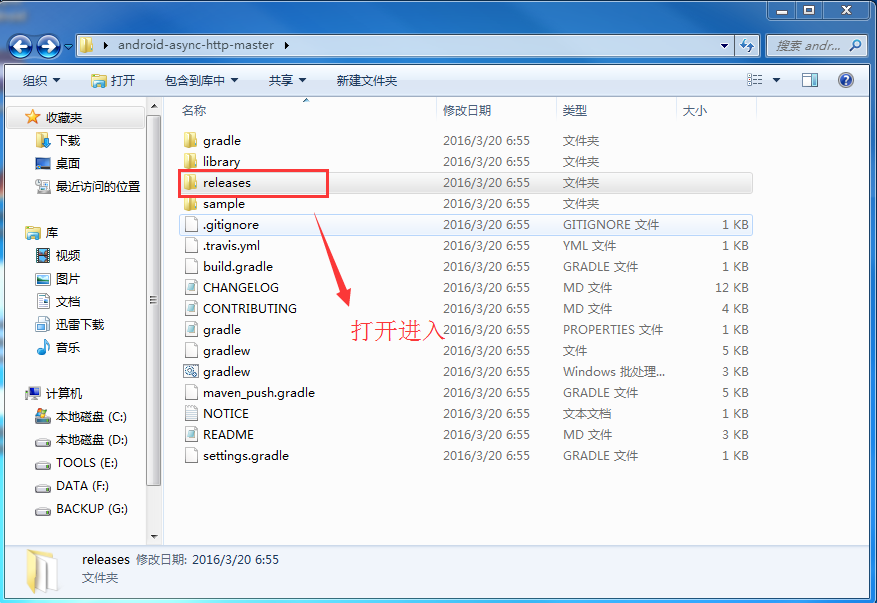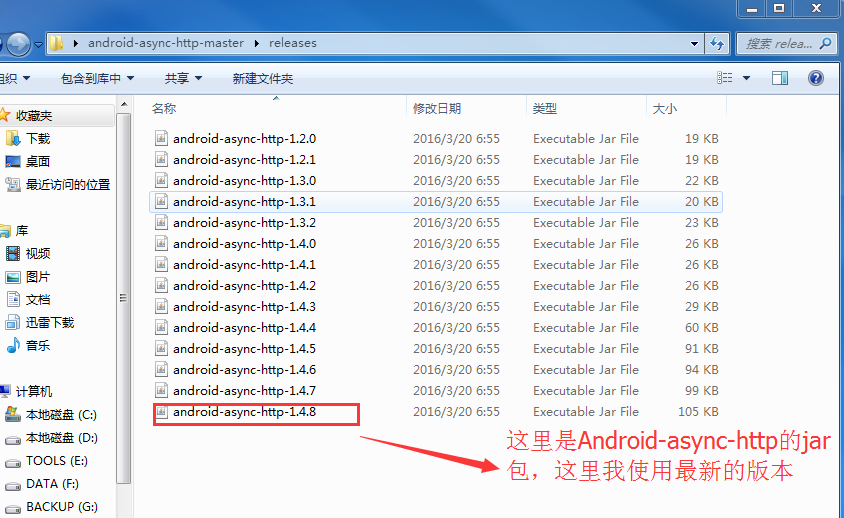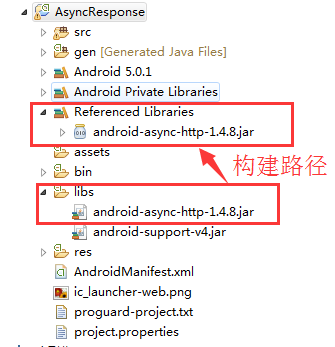4. Android框架和工具之 android-async-http
1. android-async-http 简介
HttpClient拥有众多的API,实现稳定,bug很少。
HttpURLConnection是一种多用途、轻量的HTTP客户端,使用它来进行HTTP操作可以适用于大多数的应用程序。HttpURLConnection的API比较简单、扩展容易。不过在Android 2.2版本之前,HttpURLConnection一直存在着一些bug。
比如说对一个可读的InputStream调用close()方法时,就有可能会导致连接池失效了。所以说2.2之前推荐使用HttpClient,2.2之后推荐HttpURLConnection。
好了,那现在话又说回来,在android-async-http中使用的是HttpClient。哎…好像在Volley中分析过Volley对不同版本进行了判断,所以针对不同版本分别使用了HttpClient和HttpURLConnection。还是google牛逼啊!
回过神继续android-async-http吧,不瞎扯了。android-async-http是专门针对Android在Apache的HttpClient基础上构建的异步http连接。所有的请求全在UI(主)线程之外执行,而callback使用了Android的Handler发送消息机制在创建它的线程中执行
主要有以下功能:
(1)发送异步http请求,在匿名callback对象中处理response信息;
(2)http请求发生在UI(主)线程之外的异步线程中;
(3)内部采用线程池来处理并发请求;
(4)通过RequestParams类构造GET/POST;
(5)内置多部分文件上传,不需要第三方库支持;
(6)流式Json上传,不需要额外的库;
(7)能处理环行和相对重定向;
(8)和你的app大小相比来说,库的size很小,所有的一切只有90kb;
(9)在各种各样的移动连接环境中具备自动智能请求重试机制;
(10)自动的gzip响应解码;
(11)内置多种形式的响应解析,有原生的字节流,string,json对象,甚至可以将response写到文件中;
(12)永久的cookie保存,内部实现用的是Android的SharedPreferences;
(13)通过BaseJsonHttpResponseHandler和各种json库集成;
(14)支持SAX解析器;
(15)支持各种语言和content编码,不仅仅是UTF-8;
附注:
android-async-http项目地址:https://github.com/loopj/android-async-http
android-async-http文档介绍:http://loopj.com/android-async-http/
由上面的项目地址下载开源框架,解压如下:


2. 主要类介绍
- AsyncHttpRequest
继承自Runnabler,被submit至线程池执行网络请求并发送start,success等消息
- AsyncHttpResponseHandler
接收请求结果,一般重写onSuccess及onFailure接收请求成功或失败的消息,还有onStart,onFinish等消息
- TextHttpResponseHandler
继承自AsyncHttpResponseHandler,只是重写了AsyncHttpResponseHandler的onSuccess和onFailure方法,将请求结果由byte数组转换为String
- JsonHttpResponseHandler
继承自TextHttpResponseHandler,同样是重写onSuccess和onFailure方法,将请求结果由String转换为JSONObject或JSONArray
- BaseJsonHttpResponseHandler
继承自TextHttpResponseHandler,是一个泛型类,提供了parseResponse方法,子类需要提供实现,将请求结果解析成需要的类型,子类可以灵活地使用解析方法,可以直接原始解析,使用gson等。
- RequestParams
请求参数,可以添加普通的字符串参数,并可添加File,InputStream上传文件
- AsyncHttpClient
核心类,使用HttpClient执行网络请求,提供了get,put,post,delete,head等请求方法,使用起来很简单,只需以url及RequestParams调用相应的方法即可,还可以选择性地传入Context,用于取消Content相关的请求,同时必须提供ResponseHandlerInterface(AsyncHttpResponseHandler继承自ResponseHandlerInterface)的实现类,一般为AsyncHttpResponseHandler的子类,AsyncHttpClient内部有一个线程池,当使用AsyncHttpClient执行网络请求时,最终都会调用sendRequest方法,在这个方法内部将请求参数封装成AsyncHttpRequest(继承自Runnable)交由内部的线程池执行。
- SyncHttpClient
继承自AsyncHttpClient,同步执行网络请求,AsyncHttpClient把请求封装成AsyncHttpRequest后提交至线程池,SyncHttpClient把请求封装成AsyncHttpRequest后直接调用它的run方法。
RequestParams的基础使用:
RequestParams params = new RequestParams(); params.put("username", "yanbober"); params.put("password", "123456"); params.put("email", "yanbobersky@email.com"); /** *Create RequestParams for a single parameter: */ RequestParams params = new RequestParams("single", "value"); /** *Create RequestParams from an existing Map of key/value strings: */ RequestParams params = new RequestParams(); Map<String, String> map = new HashMap<String, String>(); map.put("first_name", "jesse"); map.put("last_name", "yan"); params.put("user", map); /** *Upload a File: */ RequestParams params = new RequestParams(); params.put("file_pic", new File("test.jpg")); params.put("file_inputStream", inputStream); params.put("file_bytes", new ByteArrayInputStream(bytes))//bytes is a byte array /** *Create RequestParams from an existing set : */ RequestParams params = new RequestParams(); Set<String> set = new HashSet<String>(); set.add("haha"); set.add("wowo"); params.put("what", set); /** *Create RequestParams from an existing List : */ RequestParams params = new RequestParams(); List<String> list = new ArrayList<String>(); list.add("Java"); list.add("C"); params.put("languages", list); /** *Create RequestParams from an existing String[] : */ RequestParams params = new RequestParams(); String[] colors = { "blue", "yellow" }; params.put("colors", colors); /** *Create RequestParams from an existing Map and List (Map in List) : */ RequestParams params = new RequestParams(); List<Map<String, String>> listOfMaps = new ArrayList<Map<String, String>>(); Map<String, String> user1 = new HashMap<String, String>(); user1.put("age", "30"); user1.put("gender", "male"); Map<String, String> user2 = new HashMap<String, String>(); user2.put("age", "25"); user2.put("gender", "female"); listOfMaps.add(user1); listOfMaps.add(user2); params.put("users", listOfMaps);
3. 官方建议使用自己新建静态的AsyncHttpClient:
1 public class HttpClientUtils { 2 private static String sessionId = null; 3 private static AsyncHttpClient client = new AsyncHttpClient(); 4 private static PersistentCookieStore cookieStore ; 5 static { 6 //设置网络超时时间 7 client.setTimeout(5000); 8 } 9 10 public static void get(String url, AsyncHttpResponseHandler responseHandler) { 11 client.get(url, responseHandler); 12 13 } 14 15 public static void get(Context context,String url,ResponseHandlerInterface responseHandler) { 16 client.get(context, url, responseHandler); 17 18 } 19 20 public static void get(String url,RequestParams params, ResponseHandlerInterface responseHandler) { 21 client.get(url, params, responseHandler); 22 23 } 24 25 public static void get(Context context, String url, RequestParams params, ResponseHandlerInterface responseHandler) { 26 client.get(context, url, params, responseHandler); 27 28 } 29 30 public static void get(Context context, String url, Header[] headers, RequestParams params, ResponseHandlerInterface responseHandler) { 31 client.get(context, url, headers, params, responseHandler); 32 33 } 34 public static void post(String url,RequestParams params, ResponseHandlerInterface responseHandler){ 35 client.post(url, params, responseHandler); 36 } 37 public static AsyncHttpClient getClient(){ 38 return client; 39 } 40 41 public static String getSessionId() { 42 return sessionId; 43 } 44 45 public static void setSessionId(String sessionId) { 46 HttpClientUtils.sessionId = sessionId; 47 } 48 49 public static PersistentCookieStore getCookieStore() { 50 return cookieStore; 51 } 52 53 public static void setCookieStore(PersistentCookieStore cookieStore) { 54 HttpClientUtils.cookieStore = cookieStore; 55 client.setCookieStore(cookieStore); 56 } 57 58 }
4. 请求流程

(1)调用AsyncHttpClient的get或post等方法发起网络请求。
(2)所有的请求都走了sendRequest,在sendRequest中把请求封装为了AsyncHttpRequest,并添加到线程池执行。
(3)当请求被执行时(即AsyncHttpRequest的run方法),执行AsyncHttpRequest的makeRequestWithRetries方法执行实际的请求,当请求失败时可以重试。并在请求开始,结束,成功或失败时向请求时传的ResponseHandlerInterface实例发送消息。
(4)基本上使用的都是AsyncHttpResponseHandler的子类,调用其onStart,onSuccess等方法返回请求结果。
5. android-async-http最简单基础的使用,只需如下步骤:
-
创建一个AsyncHttpClient;
-
(可选的)通过RequestParams对象设置请求参数;
-
调用AsyncHttpClient的某个get方法,传递你需要的(成功和失败时)callback接口实现,一般都是匿名内部类,实现了AsyncHttpResponseHandler,类库自己也提供许多现成的response handler,你一般不需要自己创建。
6. android-async-http 的使用
- 在匿名callback回调中处理response信息
(1)新建一个Android工程,如下:

(2)上面要使用到网络访问,自然需要在AndroidManifest中添加网络权限。
(3)来到MainActivity,如下:
1 package com.himi.asyncresponse; 2 3 import org.apache.http.Header; 4 5 import com.loopj.android.http.AsyncHttpClient; 6 import com.loopj.android.http.AsyncHttpResponseHandler; 7 8 import android.app.Activity; 9 import android.os.Bundle; 10 11 public class MainActivity extends Activity { 12 13 @Override 14 protected void onCreate(Bundle savedInstanceState) { 15 super.onCreate(savedInstanceState); 16 setContentView(R.layout.activity_main); 17 18 AsyncHttpClient client = new AsyncHttpClient(); 19 client.get("https://www.baidu.com/", new AsyncHttpResponseHandler() { 20 21 @Override 22 public void onSuccess(int statusCode, Header[] headers, byte[] responseBody) { 23 24 System.out.println("--------onSuccess------"); 25 System.out.println("反馈结果:"); 26 System.out.println(new String(responseBody)); 27 System.out.println("状态码:"+statusCode); 28 System.out.println("header:"); 29 for(int i=0; i<headers.length; i++) { 30 System.out.println(headers[i]); 31 } 32 } 33 34 @Override 35 public void onFailure(int statusCode, Header[] headers, byte[] responseBody, Throwable error) { 36 37 /*System.out.println("--------onFailure------"); 38 System.out.println("反馈结果:"+new String(responseBody)); 39 System.out.println("状态码:"+new String(responseBody));*/ 40 } 41 42 @Override 43 public void onStart() { 44 super.onStart(); 45 System.out.println("--------onStart------"); 46 } 47 48 @Override 49 public void onFinish() { 50 super.onFinish(); 51 System.out.println("--------onFinish------"); 52 } 53 54 @Override 55 public void onRetry(int retryNo) { 56 super.onRetry(retryNo); 57 System.out.println("--------onRetry------"); 58 } 59 60 @Override 61 public void onCancel() { 62 super.onCancel(); 63 System.out.println("--------onCancel------"); 64 } 65 66 public void onProgress(int bytesWritten, int totalSize) { 67 super.onProgress(bytesWritten, totalSize); 68 System.out.println("--------onProgress------"); 69 } 70 71 }); 72 73 } 74 75 }
布署程序到模拟器上,观察Logcat如下:

上面是使用Get方法,不带参数的。
下面我们介绍使用Get方法、Post方法带参数的,基本使用如下:
带参数Get请求:
1 HttpClientUtils.get("http://www.baidu.com", new AsyncHttpResponseHandler() { 2 @Override 3 public void onSuccess(int statusCode, Header[] headers, byte[] responseBody) { 4 System.out.println(response); 5 } 6 @Override 7 public void onFailure(int statusCode, Header[] headers, byte[] responseBody, Throwable 8 error) 9 { 10 error.printStackTrace(System.out); 11 } 12 });
带参数Post请求:
1 RequestParams params = new RequestParams(); 2 params.put("value1", value1); 3 params.put("value2", value2); 4 HttpClientUtils.post(url, params, new JsonHttpResponseHandler(){ 5 @Override 6 public void onSuccess(int statusCode, Header[] headers, 7 JSONObject response) { 8 //请求成功回调 9 } 10 @Override 11 public void onFinish() { //请求完成 12 } 13 @Override 14 public void onFailure(int statusCode, Header[] headers, 15 String responseString, Throwable throwable) { 16 //请求失败 17 } 18 19 });
- 文件上传(支持断点上传)
核心代码示例:
File myFile = new File("/sdcard/test.java"); RequestParams params = new RequestParams(); try { params.put("filename", myFile); AsyncHttpClient client = new AsyncHttpClient(); client.post("http://update/server/location/", params, new AsyncHttpResponseHandler(){ @Override public void onSuccess(int statusCode, String content) { super.onSuccess(statusCode, content); } }); } catch(FileNotFoundException e) { e.printStackTrace(); }
- 支持解析成Json格式
(1)JsonHttpResponseHandler带Json参数的POST:
try { JSONObject json = new JSONObject(); json.put("username", "ryantang"); StringEntity stringEntity = new StringEntity(json.toString()); client.post(mContext, "http://api.com/login", stringEntity, "application/json", new JsonHttpResponseHandler(){ @Override public void onSuccess(JSONObject jsonObject) { super.onSuccess(jsonObject); } }); } catch (JSONException e) { e.printStackTrace(); } catch (UnsupportedEncodingException e) { e.printStackTrace(); }
(2)访问服务器端,获取json数据:
AsyncHttpClient client = new AsyncHttpClient(); String url = "http://172.16.237.227:8080/video/JsonServlet"; client.get(url, new JsonHttpResponseHandler() { // 返回JSONArray对象 | JSONObject对象 @Override public void onSuccess(int statusCode, Header[] headers, JSONArray response) { super.onSuccess(statusCode, headers, response); if (statusCode == 200) { //存储数组变量 List<String> objects = new ArrayList<>(); for (int i = 0; i < response.length(); i++) { try { // 获取具体的一个JSONObject对象 JSONObject obj = response.getJSONObject(i); objects.add(obj.getString("name")); } catch (JSONException e) { // TODO Auto-generated catch block e.printStackTrace(); } } //C控制层主要就是对数据处理 ArrayAdapter<String> adapter = new ArrayAdapter<String>(MainActivity.this, android.R.layout.simple_list_item_1, objects); //设置显示的内容 lv_users.setAdapter(adapter);// C空置 } } });
-
BinaryHttpResponseHandler下载文件:
AsyncHttpClient client = new AsyncHttpClient(); client.get("http://download/file/test.java", new BinaryHttpResponseHandler() { @Override public void onSuccess(byte[] arg0) { super.onSuccess(arg0); File file = Environment.getExternalStorageDirectory(); File file2 = new File(file, "down"); file2.mkdir(); file2 = new File(file2, "down_file.jpg"); try { FileOutputStream oStream = new FileOutputStream(file2); oStream.write(arg0); oStream.flush(); oStream.close(); } catch (Exception e) { e.printStackTrace(); Log.i(null, e.toString()); } } });
官方文档里说PersistentCookieStore类用于实现Apache HttpClient的CookieStore接口,可自动将cookie保存到Android设备的SharedPreferences中,如果你打算使用cookie来管理验证会话,这个非常有用,因为用户可以保持登录状态,不管关闭还是重新打开你的app。
PersistentCookieStore继承自CookieStore,是一个基于CookieStore的子类, 使用HttpClient处理数据,并且使用cookie持久性存储接口。
文档里介绍了持久化Cookie的步骤:
(1)创建 AsyncHttpClient实例对象;
(2)将客户端的cookie保存到PersistentCookieStore实例对象,带有activity或者应用程序context的构造方法;
(3)任何从服务器端获取的cookie都会持久化存储到myCookieStore中,添加一个cookie到存储中,只需要构造一个新的cookie对象,并且调用addCookie方法;
AsyncHttpClient client = new AsyncHttpClient(); PersistentCookieStore cookieStore = new PersistentCookieStore(this); client.setCookieStore(cookieStore); BasicClientCookie newCookie = new BasicClientCookie("name", "value"); newCookie.setVersion(1); newCookie.setDomain("mycompany.com"); newCookie.setPath("/"); cookieStore.addCookie(newCookie);



 浙公网安备 33010602011771号
浙公网安备 33010602011771号